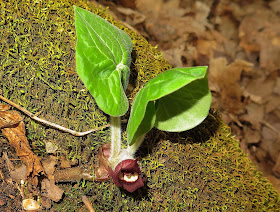With so many plants responding to Spring these days, I can hardly keep up with them! Since I use my blog as a record of how Spring progresses each year, I simply want to list (in alphabetical order) those plants I observed in the Skidmore woods this past Monday (May 4). Many neglected household tasks are calling me away from lengthy blogging at the moment.
American Beech (Fagus grandifolia). Emerging leaves covered with kitten-soft fur.
Bellwort, Large-flowered (Uvularia grandiflora)
Blue Cohosh, the yellow-flowered, later-blooming species (Caulophyllum thalictroides)
Prickly Gooseberry (Ribes cynosbati)
Bulblet Fern (Cystopteris bulbifera), newly emerged, with cherry-red stems
Canada Violet (Viola canadensis), displaying the distinctive white face and purple buds.
Dwarf Ginseng (Panax trifolius)
Early Meadow Rue, pistillate flowers (Thalictrum dioicum)
Early Meadow Rue, staminate flowers (Thalictrum dioicum)
Long-spurred Violet (Viola rostrata), the most common violet of this limestone-underlaid woods.
Maple-leaved Viburnum (Viburnum acerifolium), in bud
Miterwort (Mitella diphylla)
Moss with orange sporophytes. Baby Tooth Moss (Plagiomnium cuspidatum)?
Sedge with fine leaves and yellow staminate flowers, possibly Carex pensylvanica
Shagbark Hickory (Carya ovata), unfolding enormous leaf bud
Sharp-lobed Hepatica (Hepatica acutiloba), seed capsules and new leaves
Small-flowered Crowfoot (Ranunculus abortivus), tiny yellow flowers as shiny as stars!
Small Solomon's Seal (Polygonatum biflorum), dangling its flower buds
Trillium, Red (Trillium erectum)
Trillium, Large-flowered White (Trillium grandiflorum)
Trout Lily, Yellow (Erythronium americanum), one of the last fading blooms to be found in this woods this spring
Wild Ginger (Asarum canadense) I had to use flash to reveal the single flower hiding in the deep shadow of its leaves.
Woolly Blue Violet (Viola sororia) Distinguished by the hairiness of its leaf stalks and the undersides of its leaves, this violet once was considered a species all to itself. But now several other violets, including our smooth-stemmed Common Blue Violet, are included within the species V. sororia. To me, it has its own distinctive look, and I find it every year in the same rocky habitat I have always found it blooming in the Skidmore woods.























What an awesome catalog of wonders!
ReplyDeleteThey all might be pictures from one of my walks on Old Baldy here (except your pictures are better)!
ReplyDeleteBeautiful photos -- you're fortunate to have such a botanical treasure-trove nearby.
ReplyDeleteWonderful pictures!
ReplyDelete